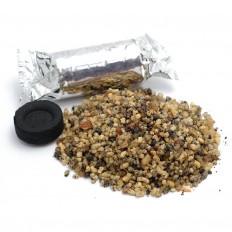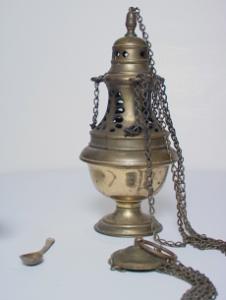



Q. 1. What is the purpose of the "incense used in the Church?"
A. 1. Incense has been used in worship by Christians since antiquity. Incense is being increasingly used among some other Christian groups as well. The practice of using incense is rooted in the earlier traditions of Judaism in the time of the Second Jewish Temple. The smoke of burning incense is interpreted by both the Western Catholic and Eastern Christian churches as a symbol of the prayer of the faithful rising to heaven. This symbolism is seen in Psalm 141:2 (140:2): "Let my prayer be directed as incense in thy sight: the lifting up of my hands, as evening sacrifice."
Incense is often used as part of a purification ritual. In the Latin rite of the Roman Catholic Church, whenever the thurible (A censer in which the incense is placed.) is swung to incense people or objects, it is always done in groups of three swings (to represent the Three Persons of the Holy Trinity, God the Father, God the Son Jesus Christ, and God the Holy Spirit; the precise number depends on the level of sanctity of the object being reverenced, and if a person whether the person is alive or dead and whether they are a cleric or a layperson, and if a cleric, their rank within the hierarchy).
In the Book of Revelation, incense symbolises the prayers of the saints in heaven - the "golden bowl full of incense" are "the prayers of the saints" (Revelation 5:8, cf. Revelation 8:3) which infuse upwards towards the Altar of God.
A thurible, a type of censer, is used to contain incense as it is burned. A server called a thurifer, sometimes assisted by a "boat bearer" who carries the receptacle for the incense, approaches the person conducting the service with the thurible charged with burning bricks of red-hot charcoal. Incense, in the form of pebbly grains or powder, is taken from what is called a "boat", and usually blessed with a prayer and spooned onto the coals. The thurible is then closed, and taken by the chain and swung by the priest, deacon or server or acolyte towards what or whom is being censed: the bread and wine offered for the Eucharist, the consecrated Eucharist itself, the Gospel during its proclamation (reading), the crucifix, the icons (in Eastern churches), the clergy, the congregation, the Paschal candle or the body of a deceased person during a funeral.
Incense may be used in Christian worship at the celebration of the Eucharist, at solemn celebrations of the Divine Office, in particular at Solemn Vespers, at Solemn Evensong, at funerals, benediction and exposition of the Eucharist, the consecration of a church or altar and at other services. [Source: https://en.wikipedia.org/wiki/Religious_use_of_incense]
Incense comes from tree resins, as well as some flowers, seeds, roots, and barks that are aromatic. The ancient religions associated their gods with the natural environment, and fragrant plant materials were believed to drive away demons and encourage the gods to appear on earth; they also had the practical aspect of banishing disagreeable odors. Fashion is intensely linked to scents, and designers include signature scents to evoke the spirit of their clothes. That perfume originated from incense shows in the word itself; per and fumum mean through and smoke in Latin.
There are two broad types of incense. Western incense is still used in churches today and comes almost exclusively from the gum resins in tree bark. The sticky gum on the family Christmas tree is just such a resin, and its wonderful scent evokes the holidays. The gum protects the tree or shrub by sealing cuts in the bark and preventing infection. In dry climates, this resin hardens quickly. It can be easily harvested by cutting it from the tree with a knife. These pieces of resin, called grains, are easy to carry and release their fragrance when they are sprinkled on burning coal.
Eastern incense is processed from other plants. Sandalwood, patchouli, agarwood, and vetiver are harvested and ground using a large mortar and pestle. Water is added to make a paste, a little saltpeter (potassium nitrate) is mixed in to help the material burn uniformly, and the mix is processed in some form to be sold for burning
For all incense, burning releases the essential oils locked in the dried resin. [Source: http://www.madehow.com/Volume-5/Incense-Stick.html]